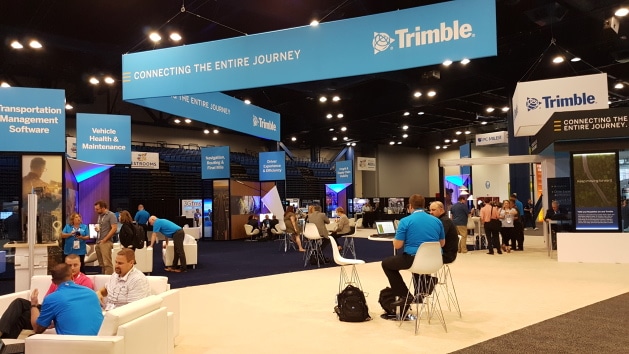Distracted driving can be costly for fleets, and tragic
HOUSTON, Texas – Collisions can be costly for fleets, and one of the most common causes of an accident is distracted driving.
Speaking during the final day of the PeopleNet in.sight User Conference in Houston, C.J. Meurell, co-founder of Motion Intelligence, said the average cost of a collision for a carrier resulting in property damage is approximately $63,000, while one involving an injury is $438,000. The number jumps significantly for an accident resulting in a fatality, with the average cost being $10.9 million.
“The last thing you want is to have your company vehicle on the six o’clock news after rear-ending a school bus,” said Meurell, adding that most fleets are self-insured, meaning they pay out of pocket when a collision occurs.
Now exceeding the cost of impaired driving, distracted driving typically involved a hand-held device such as a cellphone. Meurell said if unchecked, he sees the issue becoming worse with younger generations getting behind the wheel.
“The generation driving today wasn’t born with mobile devices,” said Meurell of the trucking industry, and pointing out that younger generations were. “If you’re a fleet owner, you are up at night worrying about all those drivers out there on the road in a fleet vehicle.”
Meurell said distracted driving for carriers all starts with the culture of your company – do you have a problem with distracted driving and are you doing anything about it?
Some best practices Meurell highlighted were to outline your expectations for your drivers, establish communication lines, get the tools you need to support your policy, and how you are going to enforce your policy.
It also helps to know your drivers, even before hiring them, and continue monitoring their driving behavior and how they comply with your company’s policy.
Motion Intelligence has created a software program to help fleets, as well as individuals, deal with distracted driving.
MI Driver Safety is a distraction management program that is installed on the mobile device and disables its use while a driver is operating a vehicle.
Using left-right acoustic signals – the same type of technology used during the Second World War – the software syncs with windshield hardware that is placed into the cab of the truck integrates with an app or fleet phone.
Location detection is accurate to three centimeters and blocks use of a mobile device when near the driver. If the phone was in the hands of a passenger and the boundaries were set up in the cab to allow for passenger use, the phone would become fully functional for the passenger after a 60-second delay period entering the safe operation area.
Meurell said with in-cab cameras not always a cost-effective option for all carriers, this new software can greatly improve safety and reduce distracted driving incidents for fleets.
Several safeguards are included in the software to combat those looking to bypass the system – including Rogue Mobile Device Detection, which detects another cellphone in the area that does not have the distracted driving software installed.
Use of Bluetooth and other safe functions of the device remain active with the software.
Meurell said most drivers will embrace any measure that makes their jobs easier and safer, and said fleets need to get their drivers involved to ensure they are informed and trained on any company initiatives, such as a distracted driver prevention program.
Latest trends
Bryan Coyne, general manager of Trimble Transportation Mobility, North America, went through a few of the latest trends in trucking during the in.sight User Conference, and in-cab video was a hot topic.
Several fleets are starting to employ the use of cameras, both forward-facing and in-cab facing to cover the company and driver in the event of an incident.
“The acceptance of video five years ago was a hard sell,” said Coyne, adding that like ELDs, drivers are warming up to the idea.
Those in attendance that used cameras on their trucks said the video is an excellent training tool for drivers.
Showing a driver video of a collision is strong message and indicator of how quickly something can go wrong while on the road.
The idea of enticing more young drivers into the industry to deal with the driver shortage was one few thought would be a successful or worthwhile effort.
Until younger people are taught that they can make a good living as a driver, most felt the trend of more going to college or university to gain quality employment would continue.
“Have to create an environment that promotes drivers,” said Coyne. “Without drivers we are dead in the water.”
Trucking associations also need to get more involved with their respective school boards to educate young people on the benefits of a career in transportation. One group that has done this is the Minnesota Trucking Association.
Good pay, equipment, and job training are also important factors to driver recruitment.
Driver communication was another trend discussed during the session.
Keeping driver in touch with dispatchers and the carrier as a whole was seen as an important aspect of driver happiness.
PeopleNet’s “next generation of the driver experience” addresses this topic, with Coyne saying, “That experience needs to be a smooth and seamless one.”

Have your say
This is a moderated forum. Comments will no longer be published unless they are accompanied by a first and last name and a verifiable email address. (Today's Trucking will not publish or share the email address.) Profane language and content deemed to be libelous, racist, or threatening in nature will not be published under any circumstances.
Pleased this article was posted. Ironic that the conference was held in Houston – where I live – and distracted driving is rather ubiquitous. Whether on surface streets or freeways, mobile devices can be seen in one hand and steering wheel in the other. Much less prevalent in states where Distracted Driving Laws are in place and enforced.